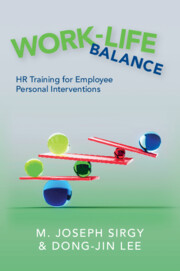Book contents
- Work-Life Balance
- Work-Life Balance
- Copyright page
- Contents
- Figures
- Tables
- Part I Making the Case for Work-Life Balance
- Chapter 1 Introduction
- Chapter 2 Why is Work-Life Balance Important?
- Chapter 3 How Does Work-Life Balance Contribute to Life Satisfaction?
- Part II Behavior-Based Personal Interventions of Work-Life Balance
- Part III Cognition-Based Personal Interventions of Work-Life Balance
- Part IV Epilogue
- Index
- References
Chapter 1 - Introduction
from Part I - Making the Case for Work-Life Balance
Published online by Cambridge University Press: 19 January 2023
- Work-Life Balance
- Work-Life Balance
- Copyright page
- Contents
- Figures
- Tables
- Part I Making the Case for Work-Life Balance
- Chapter 1 Introduction
- Chapter 2 Why is Work-Life Balance Important?
- Chapter 3 How Does Work-Life Balance Contribute to Life Satisfaction?
- Part II Behavior-Based Personal Interventions of Work-Life Balance
- Part III Cognition-Based Personal Interventions of Work-Life Balance
- Part IV Epilogue
- Index
- References
Summary
In this chapter, we discuss various definitions along with key characteristics of work-life balance. Work-life balance is defined from at least five perspectives: (1) equal engagement and satisfaction in work and nonwork domains, (2) engagement in work and nonwork roles compatible with life goals, (3) successful accomplishment of goals in work and nonwork domains, (4) full engagement in multiple life domains, and (5) minimal role conflict between work and nonwork life domains.
Keywords
- Type
- Chapter
- Information
- Work-Life BalanceHR Training for Employee Personal Interventions, pp. 3 - 15Publisher: Cambridge University PressPrint publication year: 2023



